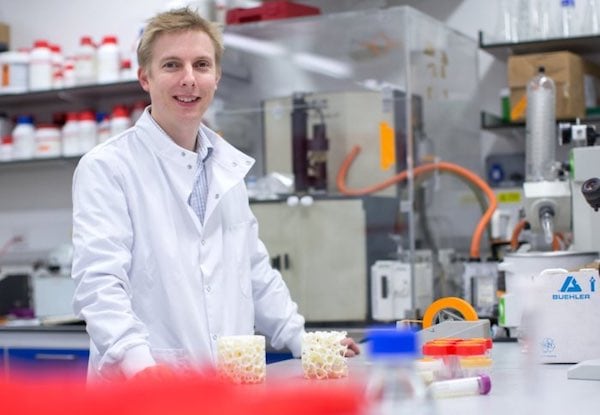
[Image above] Julian Jones is working to develop a new bouncy bioglass that shows promise for cartilage repair. Credit: Imperial College London
I’ve reported before about the materials difficulties of repairing and replacing our bodies’ joints—these areas require crucial strength yet demand wide-ranging motion, affording our bodies the ability to bend, stretch, jump, dip, dive, and dodge.
Those difficulties mean that researchers have to get creative when it comes to finding the right materials to fix joints—even so creative as marrying ceramic with silk to acquire the right consistency of strength and flexibility.
Glass, like ceramic, might not be the first material you think of when looking for strength and flexibility. But you might be surprised to see how far these materials have come from their brittle beginnings.
Bioglass in particular is an incredibly interesting material—it has shown huge promise in medicine for its ability to help heal various tissues, structures, and bodily components. It even looks good enough to eat.
And lately, bioglass research is really booming—from the material’s ability to span large-scale defects in bone to treating sensitive teeth.
Larry Hench was right—this unconventional material is showing promise for fixing nearly every part of the human body.
ACerS Fellow Julian Jones, a professor in the Department of Materials at Imperial College London, is making strides towards one day being able to fix cartilage with a new formulation of bioglass that bends and bounces.
To achieve such a consistency, Jones and fellow Imperial researchers mixed the silica bioglass with polycaprolactone to form a flexible and durable material. The new bioglass “mimics the shock-absorbing and load bearing qualities of real cartilage,” according to an Imperial press release. Watch the bioglass bounce in this short slow-motion video.
Credit: Imperial College London; YouTube
In addition to achieving the correct consistency, the team also reports that the material can be made into a biodegradable ink that can be 3-D printed into precisely the size and shape needed.
And if that wasn’t enough, the team also reports that the material is self-healing. See for yourself.
Credit: Imperial College London; YouTube
According to the release, the 3-D printed bioglass material can encourage the growth of cartilage cells in vitro, and the team thinks the same will happen in vivo.
“When implanted, the combination of the structure, stiffness and chemistry of the bioglass would encourage cartilage cells to grow through microscopic pores. The idea is that over time the scaffold would degrade safely in the body, leaving new cartilage in its place that has similar mechanical properties to the original cartilage,” the release explains.
Because cartilage is found in many crucial parts of the body, the new bioglass composite could help replace damaged intervertebral discs, fix worn-out knees, and much more. Watch a simulation of how that healing might happen in the short video below.
Credit: Imperial College London; YouTube
The team is conducting further lab trials with the technology and is working next to develop a surgical technique to implant the material, according to the release.
Does all this biomedical materials research intrigue you? Be sure not to miss the upcoming Innovations in Biomedical Materials and Technologies meeting, July 29–31, in Rosemont, Ill.
Author
April Gocha
CTT Categories
- Biomaterials & Medical
- Glass
- Manufacturing
- Material Innovations


